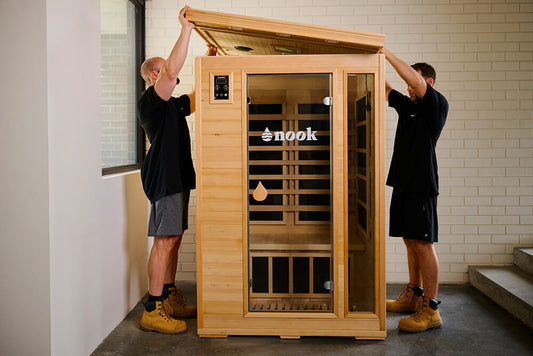Saunas have been used for centuries to promote relaxation, detoxification, and overall well-being. However, modern technology has introduced a more comfortable and efficient alternative: far infrared (FIR) saunas. Unlike traditional saunas that rely on heating the air, FIR saunas use infrared light to directly warm the body, offering numerous advantages. Here are seven key benefits of FIR saunas over traditional saunas.
1. Lower Operating Temperature for a More Comfortable Experience
Traditional saunas heat the air to a sweltering 160-200°F (70-93°C), which can feel overwhelming and stifling. In contrast, FIR saunas operate at a much gentler 110-140°F (43-60°C), allowing users to experience deep sweating and therapeutic benefits without the discomfort of extreme heat. This makes FIR saunas a more inviting option for individuals who struggle with high temperatures.
2. Deeper Detoxification at a Cellular Level
One of the most significant advantages of FIR saunas is their ability to penetrate 1.5-2 inches into the skin, stimulating detoxification at a cellular level. Traditional saunas mainly heat the surface of the skin, leading to a more superficial detox. FIR saunas, on the other hand, promote the removal of heavy metals, toxins, and impurities from deep within the body, enhancing overall health.
3. More Energy-Efficient and Cost-Effective
FIR saunas are significantly more energy-efficient than traditional saunas. They heat up faster and require less energy to maintain their optimal temperature. This not only reduces electricity costs but also makes FIR saunas a more environmentally friendly choice. Homeowners looking for an affordable sauna experience will appreciate the cost savings that come with FIR technology.
4. Easier to Install and Maintain
Installing a traditional sauna often requires complex ventilation systems and professional setup, making it a time-consuming and costly process. FIR saunas, however, are typically plug-and-play, requiring only a standard power outlet. Additionally, they have minimal maintenance needs, eliminating the hassle associated with traditional saunas.
5. Better for Respiratory Health
Traditional saunas can feel stuffy and humid, which may be uncomfortable for individuals with asthma or respiratory conditions. FIR saunas do not rely on steam or extreme heat, making them a better option for those who struggle with breathing issues. The dry, gentle warmth of an FIR sauna allows users to relax and enjoy their session without discomfort.
6. More Effective Muscle and Joint Relief
Infrared heat penetrates deep into muscles and joints, providing superior pain relief for conditions such as arthritis, fibromyalgia, and muscle soreness. Traditional saunas heat the body from the outside in, which takes longer to achieve similar therapeutic effects. FIR saunas offer more efficient relief, making them an excellent choice for athletes, chronic pain sufferers, and those recovering from injuries.
7. A Quieter and More Relaxing Experience
Traditional saunas often require heating elements, steam generators, or wood-burning stoves, which can produce noise and disrupt the relaxation experience. In contrast, FIR saunas operate silently, creating a peaceful and spa-like atmosphere. This makes them perfect for meditation, relaxation, and unwinding after a long day.
Conclusion
Far infrared saunas provide numerous advantages over traditional saunas, from a more comfortable heat range to deeper detoxification, improved energy efficiency, and easier maintenance. They are also better for respiratory health, offer superior muscle and joint relief, and create a quieter, more relaxing experience. Whether you're looking to enhance your wellness routine or invest in a cost-effective home sauna, FIR saunas are a smart and beneficial choice.



